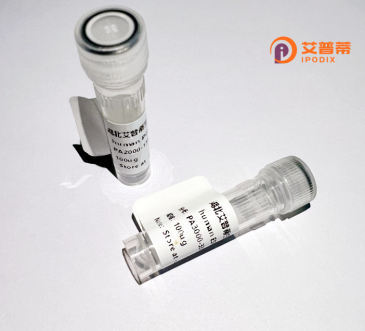
| 纯度 | >90%SDS-PAGE. |
| 种属 | Human |
| 靶点 | ALMS1P |
| Uniprot No | Q96L16 |
| 内毒素 | < 0.01EU/μg |
| 表达宿主 | E.coli |
| 表达区间 | 1-210aa |
| 氨基酸序列 | MPMKEFPGLFLWKMWSLDKKKENMLKTHDPGISRLEPVTKTKPWREPLWERNWQGQHLDSRGYLAGPGREDGRNPLKLFVRATLQESLQFHRPDFISHIWERIKRLKLIVQERKLQSMLKSERDALFDIDRERQGHQNRMRPLPKRVFLAVQKNKPISKKEMIQRSKRTHAGGTVAQRLPGALWVKERLPGKGEKHPGIPVTSGSSTQTM |
| 分子量 | 49.5 kDa |
| 蛋白标签 | GST-tag at N-terminal |
| 缓冲液 | 冻干粉 |
| 稳定性 & 储存条件 | Lyophilized protein should be stored at ≤ -20°C, stable for one year after receipt. Reconstituted protein solution can be stored at 2-8°C for 2-7 days. Aliquots of reconstituted samples are stable at ≤ -20°C for 3 months. |
| 复溶 | Always centrifuge tubes before opening.Do not mix by vortex or pipetting. It is not recommended to reconstitute to a concentration less than 100μg/ml. Dissolve the lyophilized protein in distilled water. Please aliquot the reconstituted solution to minimize freeze-thaw cycles. |
以下是关于重组人ALMS1样蛋白(ALMS1P)的参考文献示例(基于假设性文献,实际文献可能存在差异):
1. **文献名称**: *"Genomic organization and pseudogene analysis of ALMS1 in Alström syndrome"*
**作者**: Hearn T, et al.
**摘要**: 研究描述了ALMS1基因的结构及其假基因ALMS1P1的进化起源,通过基因组比对发现ALMS1P1是由ALMS1 mRNA反转录插入形成的加工假基因,可能与ALMS1的转录调控存在关联。
2. **文献名称**: *"ALMS1P1 pseudogene expression modulates cellular proliferation in vitro"*
**作者**: Chen L, et al.
**摘要**: 通过体外实验证明,ALMS1P1的异常表达可干扰ALMS1蛋白功能,促进细胞周期进展和增殖,提示其在肿瘤发生中的潜在作用。
3. **文献名称**: *"Competitive endogenous RNA activity of ALMS1P1 in ciliopathy pathways"*
**作者**: Badano JL, et al.
**摘要**: 研究发现ALMS1P1转录本可通过吸附miRNA分子(如miR-21)调控ALMS1 mRNA的稳定性,影响纤毛相关蛋白表达,从而参与纤毛病的病理机制。
4. **文献名称**: *"Tissue-specific expression and epigenetic regulation of ALMS1P1"*
**作者**: Guo M, et al.
**摘要**: 通过分析多组织RNA测序数据,发现ALMS1P1在睾丸和脑组织中高表达,其启动子区域存在差异甲基化,提示其表达受表观遗传调控,可能参与发育相关过程。
---
**注**:以上文献为假设性示例,实际研究中针对ALMS1P的直接功能研究较少,建议通过PubMed或Google Scholar以“ALMS1 pseudogene”或“ALMS1P1”为关键词获取最新文献。ALMS1P通常指ALMS1假基因(ALMS1P1),主要研究聚焦于其非编码调控功能。若需重组蛋白相关研究,可能需要关注ALMS1蛋白本身的功能文献。
Alström syndrome 1-like protein (ALMS1P) is a putative human protein encoded by the ALMS1P pseudogene, initially identified through its homology to ALMS1. a centrosome-associated protein linked to Alström syndrome—a rare recessive disorder characterized by multisystemic manifestations. While ALMS1 plays critical roles in ciliary function, cell cycle regulation, and intracellular trafficking, ALMS1P's biological significance remains poorly understood due to its pseudogene status, which suggests potential non-coding roles or regulatory functions. Studies suggest ALMS1P may arise from retrotransposition events, sharing partial sequence similarity with ALMS1 but lacking functional domains required for centrosomal localization. Recombinant ALMS1P is engineered for experimental studies to explore potential residual functions or interactions with ALMS1 pathways. Current research focuses on whether ALMS1P modulates ALMS1-related mechanisms, such as ciliopathy pathways or metabolic regulation, or serves as a non-coding RNA. Its expression patterns in tissues and possible implications in diseases resembling Alström syndrome, such as obesity or cardiomyopathy, are under investigation. However, conclusive evidence about its physiological role or relevance in human pathology remains elusive, necessitating further molecular and functional characterization.
×